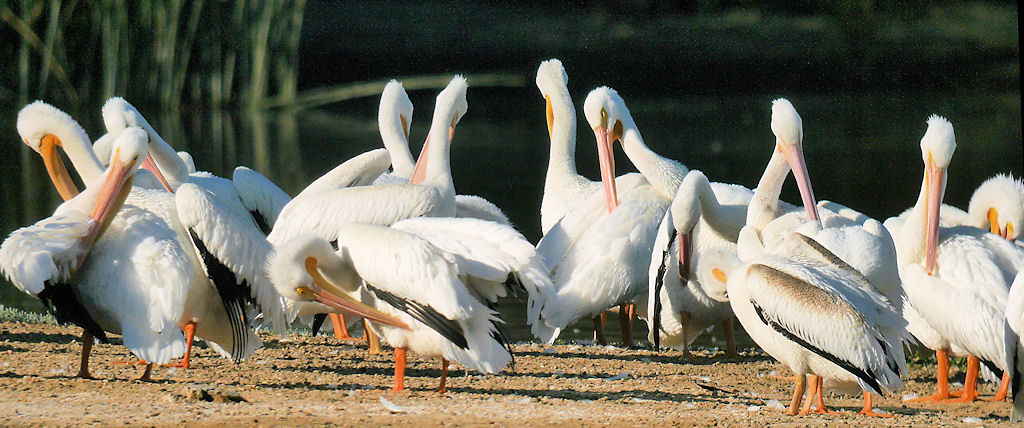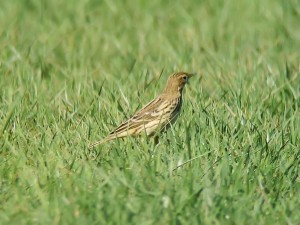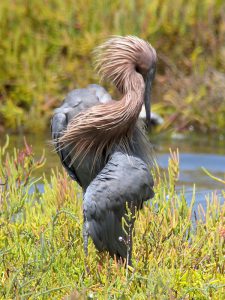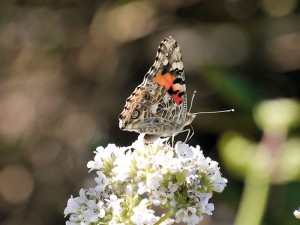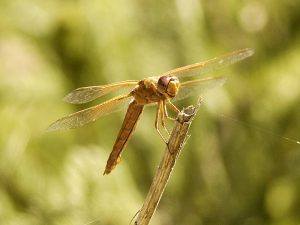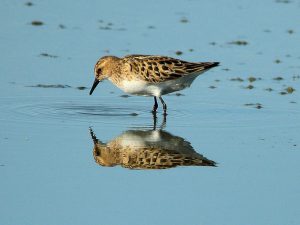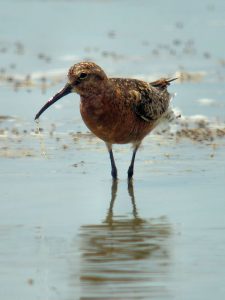The American White Pelican (Pelecanus erythrorhynchos) is one of two species of pelican in North America, along with the Brown Pelican (Pelecanus occidentalis). While occasionally seen in the same locations, American White Pelicans and Brown Pelicans prefer different habitats and their manner of feeding is as different as their plumage.
Continue reading
Tag Archives: Kowa TSN-884 Spotting Scopes
Red-throated Pipits Return to SoCal
Migration of Red-throated Pipits
One of the most amazing migratory flights is that of the Red-throated Pipit Anthus cervinus. This pipit breeds primarily in eastern Europe and Asia, almost completely above the Arctic Circle, and on the Kamchatka Peninsula. There are also some breeding grounds in Alaska’s northwest coast, Bering Sea islands, and possibly also in the Yukon.
Most Red-throated Pipits migrate down the western Pacific and winter in China and as far south as Australia. Some of the more eastern breeders take a more easterly route. These 6-inch passerines fatten up on the islands in the Bering Sea and then head off on a 3,000 mile flight across the Pacific Ocean to the California coast. While annual each October in southern California in small numbers, mostly on sod farms, Red-throated Pipits are almost unheard of much north of the San Francisco Bay Area. This tells us that they rarely follow land and fly straight across the ocean. The Red-throated Pipits that migrate through SoCal winter in Baja California. eBird records show them wintering near La Paz, Baja California Sur, Mexico. Continue reading
Dance of the Reddish Egret
When people find out I’m a birder, one of the most frequent questions is “What’s your favorite bird?” Sometimes I’ll give a flippant answer such as “My next life bird.” Other times, I’ll say that I love all birds and can’t pick a favorite – that each is special in its own way. I do have an affinity for Magnificent Frigatebirds, because seeing an adult male flying fifteen feet over my head while standing on a dock on Key West was the experience that triggered my choice to actively pursue the hobby of birding. But there are in fact some birds that are definitely cooler than others, be they prettier, uglier, sweet singers, or just plain quirky. One of these is the Reddish Egret (Egretta rufecens).
Reddish Egrets, once rare in Southern California, have been moving gradually up the coast. They now inhabit estuaries from San Diego through Ventura. Recently, they are visiting Santa Barbara. At Bolsa Chica Ecological Reserve, they are breeding. Birders frequently report sightings of 2 or 3 individuals. Continue reading
Getting Close to Bugs
The old saying goes “Close only counts in horseshoes and hand grenades.” But we who study butterflies, dragonflies, or other small creatures, know that many other things need proximity. Getting close looks at and/or photographing them requires optics that let you see these beauties in enough detail. That means being able to focus at very short distances. On the Optics4Birding website, a binocular’s close focus distance must be less than 8 feet to be considered close-focusing. I photographed these butterflies with a lens that allows close focus as well. All these images are full frame. I have not cropped the photos, only resized them to fit our page format. The Painted Lady (above) was feeding on nectar from these flowers. Continue reading
Wildlife Photography is Full of Surprises
To paraphrase Forest Gump’s mother, wildlife photography, especially video, is like a box of chocolates – you never know what you’re going to get. Animals do things on their own volition, so it always pays to wait and watch.
After looking at shorebirds along the Los Angeles River last fall, we walked back to the car through a park along the river. It was late morning and butterflies and dragonflies were quite active. Although we are primarily birders, we are interested in all of nature. So, we stopped to see what we could find.
Dragonfly Feeding Behavior
Dragonflies have two main methods of getting food: hawking and patrolling. In hawking, the dragonfly perches on the end of a branch, stump, or rock and waits for its prey to come flying by. In patrolling, the dragonfly flies up and down an area, often a path or road, and searches out its prey. Patrolling dragonflies are notoriously difficult to photograph because they are hardly ever stationary.
The Wildlife Photography Surprise
As we walked along, I noticed a Flame Skimmer. It was sitting perched on a stick in the middle of a planted area. Fortunately, Flame Skimmers are hawking dragonflies, so I decided to digiscope some video through my Kowa TSN-884 spotting scope with my micro four thirds camera. I set up, zoomed in, and started recording, waiting for something interesting to happen. The first few times the skimmer flew off its perch, I stopped recording, but it kept returning. Interested in showing that behavior, I started a new clip and decided to let the video run until it came back. Was I ever surprised and happy.

Letting the video run really paid off. When the Flame Skimmer returned to its perch, it was chewing away on a gnat! I never expected that. What a surprise! Isn’t wildlife photography fun?
Gone Fishin
We can learn a lot by watching animals. Unlike humans, they remain focused on their task at all times. This Green Heron, gone fishin at San Joaquin Wildlife Sanctuary in Irvine, California was no exception.
Green Herons, like most members of the heron and egret family, fish and crustaceans for a living. They have to get good at it to survive. Of the family members that occur in North America, the Great Blue Heron and the Cattle Egret eat land-based critters. The Great Blue Heron will eat anything it can fit in its mouth including rodents and birds. The Cattle Egret eats mostly insects, but also frogs and worms.
Season of Shorebirds – Summer 2011
The summer of 2011 is shaping up to be a fabulous season of shorebirds in California. The season kicked off with the appearance of the Lesser Sand-Plover in Orange County, CA, a cooperative bird that stayed a total of 8 days in late June, delighting many observers.
Shorebirds to the North
July has been even better with the appearance of two Little Stints, both in northern California. On the 23rd, Kimball Garrett discovered another one at Piute Ponds on the grounds of Edwards Air Force Base in northern LA County. On the same day, a Wilson’s Plover was found at the Carpinteria Salt Marsh Reserve in Carpinteria. Unfortunately it was in a restricted area where only a limited few could get access.
The Little Stint was too good to pass up, so a group of us got up before dawn the next day and made the trek north, arriving on the site by 7:15. The bird was re-found within minutes of our arrival and we began watching this rather reddish adult shortly after. After about an hour of digiscoping pictures and video, one of the observers got a phone call saying that Guy McCaskie had found an adult Curlew Sandpiper on the salt basin at Imperial Beach, south of San Diego. You could look at the birders around you and just see the wheels turning as they all began calculating time and distance, or perhaps gauging spousal approval.

Shorebirds to the South
For us, it was a no-brainer: we were going! Even with a stop or two along the way, we made it to the site just a bit before noon. We pulled together the cameras, scopes, tripods and binoculars and made the ¼-mile trek out to the site. As we arrived, we could tell something was off from the assembled crowd of birders. Strange and angry mutterings like “!*^$&% Peregrine Falcon!!” and worried bits of encouragement like “It’s got to be here somewhere!” suggested the nature of the problem. With over 20 birders searching, no one found the bird for at least an hour.
At that point, we decided to break for lunch and come back later, so we drove off in search of fast food. As it turned out, the food wasn’t fast enough: it had just been delivered to the table when the phone rang. The bird was back! Unlike the stint, this wasn’t a life bird for either of us, so we opted to hurriedly finish our sandwiches before charging back out there. Apparently everyone had heard. The crowd of birders had more than doubled, and the mood was ebullient. The bird itself was calmly feeding on the near edge of the water, evidently oblivious to the mob of admirers mere yards away. It put on quite a show, feeding and preening and occasionally lifting its wings.

Season of Shorebirds Continues
Since then, two more great shorebirds have shown up, although both are way further north again. On the 26th, a Red-necked Stint appeared in Coos County Oregon. On August 5th, Ryan Merrill found a Wood Sandpiper at Samish Flats, WA. For those of you on the left coast, you might want to hit any marsh, lake, bay or beach with any kind of suitable habitat. And for those of you from more distant locales, you might want to check your opportunities for standby flights. Who knows what could show up in a year like this!
Digiscoped Video – American Oystercatcher
On Saturday, May 22, 2010, I followed up on a report of an American Oystercatcher at a few locations in Laguna Beach. I tried Crescent Bay first, and was fortunate to find five Oystercatchers on the rocks below the point. There were three Black Oystercatchers, while the other two looked pretty good for Americans.
What are they?
Black and American Oystercatchers interbreed and their hybrid offspring can be anywhere on a cline from pure Black to pure American. We had to evaluate these birds for purity. J. R. Jehl, Jr. developed a rating system used by ornithologists to determine where on the cline a given bird falls. Because there are several genetic variations that are involved, we use ten different characteristics to judge the birds. Nine of them have a score between 0 and 4. The belly coloration goes from 0 to 6. A bird with a score of 0 to 9 rates is a pure Black Oystercatcher. One scored from 30 to 38 is pure American, and everything in between is a hybrid.
I took this video with a Nikon CoolPix P6000 attached to a Kowa TSN-884 spotting scope at a distance of 96 yards measured by a Zeiss Victory PRF laser rangefinder.

Is Either an American Oystercatcher?
The Oystercatcher in the center of this video has white upper tail coverts (Jehl’s score 4), basal half of all retrices were white (4), chest sharply delimited black to white on upper chest (4), belly entirely white (6), undertail coverts entirely white (4), thighs entirely white (4), greater secondary coverts 6-15mm (3), white present on some of inner primaries (3), underwing coverts entirely white (4), axillaries entirely white (4). The Jehl’s score for this American Oystercatcher is 36 out of 38.
The hybrid Oystercatcher, seen on the left as the video starts, has upper tail coverts black (Jehl’s score 0), retrices mainly black with some white in the vanes (1), black chest bordered by jagged edge on upper chest (3), belly entirely white (6), undertail coverts mainly white (3), thighs entirely white (4), greater secondary coverts 6-15mm (3), white present on secondaries but not primaries (2), underwing coverts mainly white (3), axillaries entirely white (4). Jehl’s score is 28 out of 38, so close, but not close enough.

